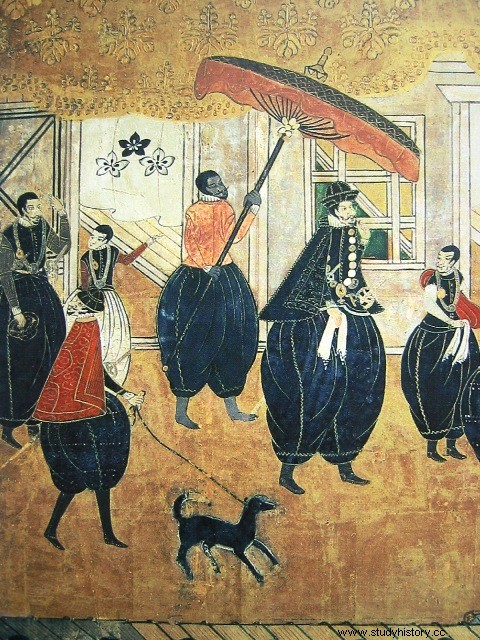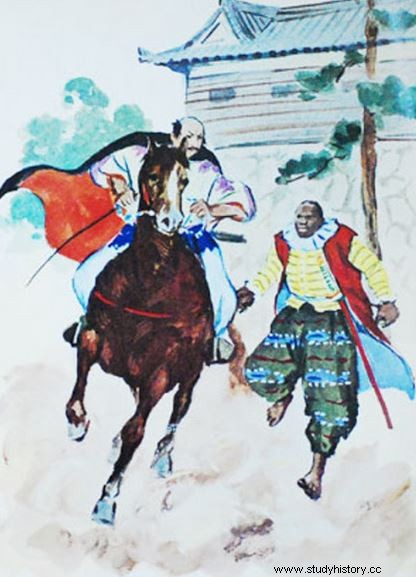In the middle of the 16th century, the coasts of Japan began to be frequented by Portuguese and Spanish ships, which at that time were already sailing the Pacific like someone going from Santurce to Bilbao. In addition to the usual silks and spices, these merchants used to also carry, as part of the lot, crews of missionaries, mostly Jesuits, eager to collect fresh souls for the Lord through those pagan lands. And it must be said that there were not a few Japanese nobles who viewed this new religion with curiosity, and even with good eyes. One of these fans of foreign novelties was Oda Nobunaga , the first of the three great unifiers of the insular empire, who by 1580 had managed to bring half the country under his control and keep the other half on a short leash. It was no exaggeration to consider him the de facto king of Japan. A man of restless intelligence and forward-looking views, Nobunaga was on good terms with the Jesuits and, although converting to Christianity was not in the plans of a convinced atheist like him, he liked to receive the friars in audience from time to time to find out how they were doing. it was the world beyond the confines of the Japanese archipelago.

Oda Nobunaga, the great unifier of Japan
But the chronicles tell that, one fine day in 1581, the peace that Nobunaga had managed to impose with so much effort in the capital was suddenly altered by the arrival of a picturesque guest. Recently arrived in Kyoto, the visiting father of the Jesuits, Alessando Valignano , he brought in his entourage someone whose real name we do not know, but whom the Japanese would soon baptize as Yasuke :
He would have brought Father Alexandre with him from the Indies, a Mauro vassal, as black as the Ethiopians of Guinea, but a native of Mozambique, one of those who are properly called Kaffirs, inhabitants of the Cape of Good Hope.
We don't know if Yasuke he was the first black person to set foot in Japan, as it was not uncommon to find African slaves on European galleons at the time. But, apparently, he must have been the first black they saw in the Japanese capital, because the people of Kyoto went crazy with him. An excited crowd gathered day and night at the gates of the Jesuit residence. There were even brawls with clean stones to catch a good place from which to see the portent. Everyone wanted to see that mysterious man with skin as dark as coal. The authorities, overwhelmed, had to intervene to put order in that mess. And, back then, the authority in Kyoto was Nobunaga. As soon as he found out about the uproar, he didn't have time to summon the Jesuit bigwig to court and see in person the cause of so much hubbub. When he saw Yasuke appear before his eyes, he was shocked. He couldn't believe that skin, sallow black, was real. In fact, suspecting that the Jesuits were trying to give it to him with cheese and in reality it was nothing more than a daubed type of bitumen, Nobunaga sent for a tub of water and, after putting it in a minced ball, had the poor slave soaped up. awareness. Only after seeing that, wash after wash, it did not fade, Nobunaga was convinced that there was no trick or cardboard. Sure enough, he had before him a black guy like a moonless night.

Black slaves and European merchants seen by the artists of the time
Lord of the Oda , always a friend of novelties, he was delighted with the discovery, and managed to get the Jesuits to give him Yasuke to put him at his service. But Yasuke A savvy little guy with a gift for tongues, he would be more than just a new addition to Nobunaga's collection of oddities. The chronicles of the time describe it as follows:
He appears between 26 or 27 years old, big and dark as an ox; he has the strength of ten men and good judgment.
According to accounts, he became a prominent member of his entourage, to the point of arousing jealousy and intrigue in the palace. The bad leagues said that Nobunaga, as satisfied with his services as he was, would end up naming him lord of some castle the least expected day. Although there is no record of it, there are those who even assure that he came to arm it as a samurai. This extreme is unlikely but, knowing the Lord of the Oda and his taste for eccentricities, it is not entirely ruled out either (In fact, some children's stories tell and draw it that way). If anyone ever had a black samurai in his service, it was Nobunaga,

Yasuke as a hero of a children's storybook
No one knows how far Yasuke might have gone in court. When Nobunaga died in 1582, the track of him vanishes forever in the mists of history. It is said that he was present on the fateful night Nobunaga fell victim to Akechi Mitsuhide's” treacherous attack. , one of his own generals. In one of the most famous episodes in the history of Japan, for reasons that are still unclear 400 years later, Mitsuhide decided to rebel against his lord and fall by surprise on the temple of Honnoji , in Kyoto, where Nobunaga spent the night peacefully protected by a small garrison before joining the bulk of his troops and leaving for battle. By dawn, the flames had consumed Honnoji to the foundations and Nobunaga's corpse would disappear forever in the ashes of it.
They say, Yasuke he would have been part of that small garrison of loyalists and would have beaten the copper like any other samurai trying to avoid the inevitable. Amid smoldering embers, the rebel troops found him and brought him to their general, Mitsuhide, who must have thought his head was not worth adding to the vast collection they had already amassed and sent him to the "barbarian temple ” (that is, the Jesuit church in Kyoto) so that his people could take care of him.

Modern illustration of Yasuke escorting his lord
Most likely, under the tutelage of the friars, he ended up in Goa or one of his other missions in Asia. Who knows, maybe good old Yasuke was lucky enough to return home and end his days in his native Mozambique. To be sure, he would have had a good repertoire of stories with which to astonish his compatriots on his return. Samurai or not, he could boast of having served in the court of the most powerful lord in Japan. Not bad for someone who started his journey covered in chains on a slave ship.
Contributed by R. Ibarzabal , from Samurai Stories
Sources:The Chronicle of Lord Nobunaga – Ota Gyuichi; Interracial Intimacy in Japan:Western Men and Japanese Women – Gary Leupp; Histoire ecclesiastique des isles et royaumes du Japon – François Solier
